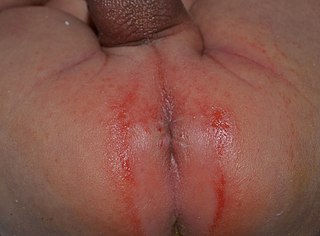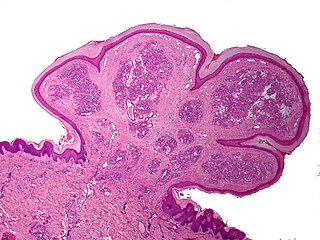Related Research Articles

Dermatitis is inflammation of the skin, typically characterized by itchiness, redness and a rash. In cases of short duration, there may be small blisters, while in long-term cases the skin may become thickened. The area of skin involved can vary from small to covering the entire body. Dermatitis is often called eczema, and the difference between those terms is not standardized.

Irritant diaper dermatitis is a generic term applied to skin rash in the diaper area that are caused by various skin disorders and/or irritants.

A granuloma is an aggregation of macrophages that forms in response to chronic inflammation. This occurs when the immune system attempts to isolate foreign substances that it is otherwise unable to eliminate. Such substances include infectious organisms including bacteria and fungi, as well as other materials such as foreign objects, keratin, and suture fragments.

Contact dermatitis is a type of acute or chronic inflammation of the skin caused by exposure to chemical or physical agents. Symptoms of contact dermatitis can include itchy or dry skin, a red rash, bumps, blisters, or swelling. These rashes are not contagious or life-threatening, but can be very uncomfortable.

Nummular dermatitis is one of the many forms of dermatitis. It is characterized by round or oval-shaped itchy lesions. The name comes from the Latin word "nummus," which means "coin."
Bromoderma is a skin condition characterized by an eruption of papules and pustules on the skin. It is caused by hypersensitivity to bromides, such as those found in certain drugs. There is at least one reported case of bromoderma caused by excessive consumption of a soft drink containing brominated vegetable oil.

A pyogenic granuloma or lobular capillary hemangioma is a vascular tumor that occurs on both mucosa and skin, and appears as an overgrowth of tissue due to irritation, physical trauma, or hormonal factors. It is often found to involve the gums, skin, or nasal septum, and has also been found far from the head, such as in the thigh.

Granuloma annulare (GA) is a common, sometimes chronic skin condition which presents as reddish bumps on the skin arranged in a circle or ring. It can initially occur at any age, though two-thirds of patients are under 30 years old, and it is seen most often in children and young adults. Females are two times as likely to have it as males.
Acral persistent papular mucinosis (APPM) is a rare form of lichen myxedematosus. It is characterized by small papules on the backs of the hands, wrists, and extensor aspects of the distal forearms, with no further clinical or laboratory indications. Lesions tend to persist and may grow in number gradually. Because there are no symptoms, treatment is rarely required.
Silicone granulomas are a skin condition that occur as a reaction to liquid silicones, and are characterized by the formation of nodules.

Majocchi's granuloma is a skin condition characterized by deep, pustular plaques, and is a form of tinea corporis. It is a localized form of fungal folliculitis. Lesions often have a pink and scaly central component with pustules or folliculocentric papules at the periphery. The name comes from Domenico Majocchi, who discovered the disorder in 1883. Majocchi was a professor of dermatology at the University of Parma and later the University of Bologna. The most common dermatophyte is called Trichophyton rubrum.
Annular elastolytic giant-cell granuloma is a cutaneous condition characterized histologically by a dermal infiltrate of macrophages.
Indeterminate cell histiocytosis(LCH) is an uncommon proliferative illness where the predominant cells have characteristics from both non-Langerhans cell histiocytosis (NLCH) and Langerhans cell histiocytosis (LCH) in terms of morphology and immunophenotypic characteristics. Wood et al. originally described ICH in 1985 as a neoplastic disease arising from dermal indeterminate cells that lack Birbeck granules but are characteristically positive for S-100 and CD1a.

Streptococcal intertrigo is a skin condition that is secondary to a streptococcal bacterial infection. It is often seen in infants and young children and can be characterized by a fiery-red color of the skin, foul odor with an absence of satellite lesions, and skin softening in the neck, armpits or folds of the groin. Newborn children and infants commonly develop intertrigo because of physical features such as deep skin folds, short neck, and flexed posture. Prompt diagnosis by a medical professional and treatment with topical and/or oral antibiotics can effectively relieve symptoms.

Airbag dermatitis is skin irritation secondary to the deployment of airbags. The diagnosis of "air bag dermatitis" is relatively recent; the first case was reported in 1994.
Infantile acne is a form of acneiform eruption that occurs in infants from 6 weeks to 1 year of age. Typical symptoms include inflammatory and noninflammatory lesions, papules and pustules most commonly present on the face. No cause of infantile acne has been established but it may be caused by increased sebaceous gland secretions due to elevated androgens, genetics and the fetal adrenal gland causing increased sebum production. Infantile acne can resolve by itself by age 1 or 2. However, treatment options include topical benzyl peroxide, topical retinoids and topical antibiotics in most cases.
Idiopathic facial aseptic granuloma is a cutaneous condition characterized by a chronic, painless, solitary nodule, reminiscent of an acne nodule, appearing on the cheeks of young children. It has a prolonged course, but spontaneously heals.
Perianal cellulitis, also known as perianitis or perianal streptococcal dermatitis, is a bacterial infection affecting the lower layers of the skin (cellulitis) around the anus. It presents as bright redness in the skin and can be accompanied by pain, difficulty defecating, itching, and bleeding. This disease is considered a complicated skin and soft tissue infection (cSSTI) because of the involvement of the deeper soft tissues.
Fiddler's neck is an occupational disease that affects violin and viola players.
References
- ↑ Rapini, Ronald P.; Bolognia, Jean L.; Jorizzo, Joseph L. (2007). Dermatology: 2-Volume Set. St. Louis: Mosby. ISBN 978-1-4160-2999-1.
- ↑ De Zeeuw R, Van Praag MC, Oranje AP (2000). "Granuloma gluteale infantum: a case report". Pediatr Dermatol. 17 (2): 141–3. doi:10.1046/j.1525-1470.2000.01734.x. hdl: 1765/56610 . PMID 10792807. S2CID 23487761.
- ↑ Leung, Alexander K. C.; Leong, Kin Fon; Lam, Joseph M. (June 7, 2021). "Successful Treatment of Recalcitrant Granuloma Gluteale Infantum with Topical Tacrolimus 0.03% Ointment". Case Reports in Pediatrics. Hindawi Limited. 2021: 1–5. doi: 10.1155/2021/9994067 . ISSN 2090-6811. PMC 8203409 . PMID 34194861.
- ↑ Konya, Joseph; Gow, Elizabeth (1996). "Granuloma gluteale infantum". Australasian Journal of Dermatology. Wiley. 37 (1): 57–58. doi:10.1111/j.1440-0960.1996.tb00999.x. ISSN 0004-8380. S2CID 29839550.
- ↑ Pons, S (1976). "[Granuloma gluteale infantum]". Medicina Cutanea Ibero-latino-americana. 4 (5): 359–364. PMID 1035390.
- ↑ Dytoc, Marlene T.; Fiorillo, Loretta; Liao, Janice; Krol, Alfons L. (June 1, 2002). "Granuloma Gluteale Adultorum Associated with Use of Topical Benzocaine Preparations: Case Report and Literature Review". Journal of Cutaneous Medicine and Surgery: Incorporating Medical and Surgical Dermatology. SAGE Publications. 6 (3): 221–225. doi:10.1007/s10227-001-0042-9. ISSN 1203-4754. PMID 12001002.
- ↑ Mostafa, Wedad Z.; Abahussein, Abdulaziz A.; Alzayer, Ahmed A. (1992). "Diaper Area Granuloma of Incontinence". The Journal of Dermatology. Wiley. 19 (5): 319–322. doi:10.1111/j.1346-8138.1992.tb03232.x. ISSN 0385-2407. PMID 1644958. S2CID 32495128.
- ↑ De Zeeuw, Raymond; Van Praag, Marinus C. G.; Oranje, Arnold P. (2000). "Granuloma Gluteale Infantum: A Case Report". Pediatric Dermatology. Wiley. 17 (2): 141–143. doi:10.1046/j.1525-1470.2000.01734.x. ISSN 0736-8046. PMID 10792807. S2CID 23487761.
- ↑ Walsh, S S; Robson, W J (June 1, 1988). "Granuloma gluteale infantum: an unusual complication of napkin dermatitis". Emergency Medicine Journal. BMJ. 5 (2): 113–115. doi:10.1136/emj.5.2.113. ISSN 1472-0205. PMC 1285498 . PMID 3408529.
- ↑ Al-Natour, SaharH; Al-Faraidy, NadyaA (2010). "A forgotten complication of diaper dermatitis: Granuloma gluteale infantum". Journal of Family and Community Medicine. Medknow. 17 (2): 107. doi: 10.4103/1319-1683.71994 . ISSN 2230-8229. PMID 21359035.
- ↑ Ingersoll, Zachary; Garza-Chapa, Juana Irma; Pham, Ryan; Malouf, Peter; Susa, Joseph; Weis, Stephen (August 23, 2018). "Recurrent Granuloma Gluteale Infantum Secondary to Fecal Overflow Incontinence". Case Reports in Dermatology. S. Karger AG. 10 (2): 203–207. doi:10.1159/000492270. ISSN 1662-6567. PMC 6167654 . PMID 30283312.